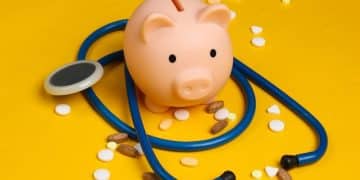Lower Blood Pressure: 3-Month US Guide Naturally

Lowering blood pressure naturally within three months involves a holistic approach integrating dietary changes, regular physical activity, stress management, and lifestyle adjustments tailored for US residents seeking sustainable health improvements.
Embarking on a journey to manage blood pressure can feel daunting, but imagine achieving significant, natural improvements within just three months. For US residents seeking to lower their blood pressure naturally, this guide offers a structured and actionable plan designed to empower you with the knowledge and tools for lasting cardiovascular health.
Understanding Hypertension and Its Impact
High blood pressure, or hypertension, is a pervasive health concern affecting millions across the United States. Often dubbed the “silent killer,” its insidious nature means it can progress without noticeable symptoms, quietly damaging arteries and increasing the risk of serious health complications like heart attack, stroke, and kidney disease. Recognizing its prevalence and potential severity is the first pivotal step towards effective management and prevention.
The Centers for Disease Control and Prevention (CDC) estimates that nearly half of adults in the US have hypertension, underscoring the critical need for awareness and proactive intervention. Lifestyle choices, genetics, age, and underlying health conditions all contribute to an individual’s susceptibility. Understanding your personal risk factors and monitoring your blood pressure regularly are fundamental practices for early detection and control.
The Numbers Game: What Do Your Readings Mean?
Blood pressure readings consist of two numbers: systolic (the top number, indicating pressure when your heart beats) and diastolic (the bottom number, pressure between beats). Optimal blood pressure is generally considered less than 120/80 mmHg. Consistently elevated readings, even those trending upwards, warrant attention and action. Knowing your numbers is empowering, allowing you to track progress and make informed decisions about your health journey.
- Normal: Less than 120/80 mmHg
- Elevated: Systolic 120-129 AND diastolic less than 80 mmHg
- High Blood Pressure (Hypertension Stage 1): Systolic 130-139 OR diastolic 80-89 mmHg
- High Blood Pressure (Hypertension Stage 2): Systolic 140 or higher OR diastolic 90 or higher mmHg
It’s important to remember that a single high reading doesn’t necessarily mean you have hypertension. Consistent high readings over time, however, do indicate a problem that needs to be addressed. Consulting with a healthcare professional for an accurate diagnosis and personalized advice is always recommended before implementing significant lifestyle changes.
Understanding hypertension is not about fear, but about empowerment. Knowledge equips you to take control of your health. The journey to lower blood pressure naturally begins with this foundational understanding, setting the stage for the practical steps that follow.
Month 1: Laying the Foundation – Diet and Hydration
The first month of this 3-month plan focuses intensely on dietary overhauls and optimal hydration, which are cornerstones of natural blood pressure reduction. What you consume plays a direct and significant role in your cardiovascular health. Shifting towards a heart-healthy diet can yield remarkable results, often within weeks, and provides a sustainable framework for long-term well-being.
For US residents, this means consciously moving away from the typical Western diet, which is often high in processed foods, sodium, unhealthy fats, and added sugars. Instead, the emphasis will be on whole, unprocessed foods that are rich in nutrients and naturally beneficial for blood pressure regulation. Consistency in this initial phase is paramount for building new habits and seeing tangible progress.
Embracing the DASH Diet Principles
The Dietary Approaches to Stop Hypertension (DASH) diet is not merely a diet; it’s an eating pattern specifically designed to lower blood pressure. It emphasizes fruits, vegetables, whole grains, lean protein, and low-fat dairy, while limiting saturated and trans fats, cholesterol, and added sugars. Integrating DASH principles into your daily routine offers a powerful, evidence-based strategy.
- Increase Fruits and Vegetables: Aim for 4-5 servings of each per day. These are rich in potassium, magnesium, and fiber, all crucial for blood pressure control.
- Choose Whole Grains: Opt for whole-grain breads, cereals, pasta, and brown rice over refined grains. They provide fiber and help with satiety.
- Lean Proteins and Healthy Fats: Incorporate poultry, fish, beans, nuts, and seeds. Limit red meat and unhealthy fats.
- Low-Fat Dairy: Include skim milk, low-fat yogurt, and cheese.
Beyond the DASH guidelines, paying meticulous attention to sodium intake is non-negotiable. Sodium is a primary culprit in elevating blood pressure for many. The average American consumes far too much sodium, largely from processed foods, restaurant meals, and packaged goods. Learning to read food labels and opting for fresh, home-cooked meals provides greater control over your sodium consumption.
Hydration cannot be overstated. Water is essential for maintaining proper blood volume and kidney function, both directly impacting blood pressure. Aim for at least 8 glasses of water daily, and consider replacing sugary drinks with water. This simple change can have a surprisingly positive effect on overall health and energy levels.

The first month is about retraining your palate and transforming your grocery list. It’s a commitment to mindful eating and consistent hydration. You might find it challenging initially, but the potential health benefits are a powerful motivator to persist. Focus on incremental changes, celebrate small victories, and remember that every healthy bite contributes to a healthier heart.
Month 2: Incorporating Regular Physical Activity and Stress Management
As you solidify your dietary habits from month one, month two introduces two equally critical components for naturally lowering blood pressure: consistent physical activity and effective stress management. Both profoundly influence cardiovascular health and, when integrated systematically, can significantly amplify the positive effects seen from dietary changes. For US residents, finding accessible and enjoyable ways to move and relax is key to long-term adherence.
Physical inactivity is a major risk factor for hypertension. Regular exercise strengthens the heart, allowing it to pump blood more efficiently with less effort, which in turn lowers blood pressure. Stress, on the other hand, triggers a “fight or flight” response that temporarily raises blood pressure and, if chronic, can contribute to sustained hypertension. Addressing both areas is vital for a holistic approach to blood pressure control.
Designing Your Exercise Routine
The goal is to incorporate at least 150 minutes of moderate-intensity aerobic activity, or 75 minutes of vigorous-intensity activity, per week. This isn’t about becoming a marathon runner; it’s about consistent movement. Moderate intensity means you can talk but not sing during the activity.
- Walking: Brisk walking is an excellent starting point. Aim for 30 minutes, most days of the week.
- Cycling: Whether outdoors or on a stationary bike, cycling is low-impact and effective.
- Swimming: A full-body workout that’s gentle on joints.
- Dancing: An enjoyable way to get your heart rate up.
In addition to aerobic exercises, consider incorporating strength training two to three times a week. This doesn’t mean heavy lifting; bodyweight exercises, resistance bands, or light weights can suffice. Strength training helps build muscle mass, which boosts metabolism and contributes to overall cardiovascular fitness.
Finding an activity you genuinely enjoy is crucial for sustainability. If exercise feels like a chore, you’re less likely to stick with it. Explore different options until you discover what resonates with you. The US offers numerous parks, walking trails, community centers, and fitness classes, providing diverse opportunities to stay active.
Mastering Stress Reduction Techniques
Chronic stress maintains blood pressure at elevated levels and can indirectly lead to unhealthy coping mechanisms, such as poor diet or lack of exercise. Learning to manage stress effectively is just as important as diet and exercise in regulating blood pressure. This month focuses on identifying stressors and implementing strategies to mitigate their impact.
- Mindfulness and Meditation: Even 10-15 minutes daily can significantly reduce stress levels. Apps like Calm or Headspace can guide you.
- Deep Breathing Exercises: Simple techniques like box breathing can calm the nervous system instantly.
- Yoga or Tai Chi: These practices combine physical movement with mindfulness, promoting relaxation.
- Spending Time in Nature: Being outdoors has been shown to reduce stress hormones and lower blood pressure.
It’s important to understand that stress cannot be entirely eliminated, but your reaction to it can be managed. Dedicate time each day to a stress-reducing activity, even if it’s just five minutes of quiet reflection. Prioritizing mental well-being is an active step in your journey to naturally lower blood pressure and achieve holistic health.
Month 3: Fine-Tuning Lifestyle and Long-Term Sustainability
In the final month of this 3-month guide, the focus shifts to consolidating the healthy habits established in the previous two months and fine-tuning other crucial lifestyle factors to ensure long-term sustainability for naturally low blood pressure. This phase is about reinforcement, minor adjustments, and preparing for a lifetime of improved cardiovascular health. For US residents, integrating these sustainable practices into daily life prevents relapse and maintains progress.
By now, you should be experiencing noticeable positive changes in your blood pressure readings and overall well-being. This month aims to solidify these gains by addressing factors like sleep, alcohol consumption, and smoking, while also emphasizing the importance of consistent monitoring and professional medical guidance. The goal is to make these healthy choices second nature, not temporary fixes.
Prioritizing Quality Sleep
Sleep plays a vital, yet often underestimated, role in blood pressure regulation. Chronic sleep deprivation or poor sleep quality can elevate blood pressure and increase the risk of hypertension. During sleep, your blood pressure naturally dips, giving your heart and blood vessels a much-needed rest. Consistent lack of this restorative period can disrupt the body’s natural rhythms.
- Aim for 7-9 Hours: Most adults need this amount of sleep for optimal health.
- Establish a Routine: Go to bed and wake up at the same time each day, even on weekends.
- Create a Relaxing Environment: Ensure your bedroom is dark, quiet, cool, and free from electronic devices.
- Avoid Stimulants: Limit caffeine and heavy meals before bedtime.
If you suspect sleep apnea or other sleep disorders, it’s crucial to consult a healthcare professional. Addressing these underlying issues can have a significant positive impact on your blood pressure and overall health.
Moderating Alcohol Consumption and Quitting Smoking
For US residents seeking to lower blood pressure, moderating alcohol intake and completely eliminating tobacco use are non-negotiable. Excessive alcohol consumption can raise blood pressure, counteract the effects of blood pressure medications, and add empty calories. Smoking, on the other hand, causes immediate, temporary increases in blood pressure and damages blood vessel walls, stiffening arteries over time.
- Alcohol Moderation: If you drink alcohol, do so in moderation. For healthy adults, this means up to one drink per day for women and up to two drinks per day for men.
- Smoking Cessation: Quitting smoking is one of the most impactful steps you can take for your cardiovascular health. Resources like the American Lung Association and CDC offer support programs.
These adjustments can be challenging, but the health benefits, including lower blood pressure and reduced risk of heart disease, are immense. Seek support from healthcare providers, support groups, or loved ones if you face difficulties.

This final month solidifies your commitment to a healthier lifestyle. It’s about maintaining consistency, being proactive in managing all aspects of your well-being, and understanding that natural blood pressure control is an ongoing journey. Regular check-ups with your doctor, even after achieving your targets, will ensure you stay on the right track and make any necessary adjustments.
Nutritional Powerhouses for Blood Pressure Control
While the DASH diet provides a comprehensive framework, certain foods stand out as particular powerhouses for naturally lowering blood pressure due to their rich content of specific minerals, antioxidants, and compounds. Incorporating these nutritional champions into your daily meals can provide an extra boost to your blood pressure management efforts, complementing the broader dietary changes. For US residents, many of these ingredients are readily available and can be seamlessly integrated into diverse cuisines.
The key nutrients to focus on are potassium, magnesium, calcium, and nitrates, along with various antioxidants. These work synergistically to relax blood vessels, reduce sodium’s effects, and support overall cardiovascular function. Understanding which foods are naturally rich in these elements empowers you to make smarter choices at the grocery store and in the kitchen.
Potassium-Rich Foods
Potassium helps to balance sodium levels in the body, mitigating its pressure-raising effects and helping to relax blood vessel walls. Many common fruits and vegetables are excellent sources:
- Bananas: A classic source, easy to incorporate into breakfast or snacks.
- Sweet Potatoes: Versatile and packed with potassium and fiber.
- Spinach and Leafy Greens: High in potassium, magnesium, and nitrates.
- Avocados: A good source of healthy fats and potassium.
While potassium supplements exist, it’s generally safer and more effective to obtain potassium from food sources. Excessive potassium, especially from supplements, can be dangerous for individuals with certain kidney conditions.
Magnesium and Calcium Sources
Magnesium plays a role in relaxing smooth muscle in blood vessels, which helps to lower blood pressure. Calcium also contributes to proper muscle function, including the heart muscle, and influences blood vessel constriction and dilation.
- Magnesium: Nuts (almonds, cashews), seeds (pumpkin, chia), whole grains (quinoa, brown rice), dark chocolate, and beans are rich in magnesium.
- Calcium: Low-fat dairy products (milk, yogurt, cheese), fortified plant milks, leafy greens (kale, collard greens), and fortified cereals are good sources.
Ensuring adequate intake of these minerals through your diet can support healthy blood pressure levels. Many of the foods recommended in the DASH diet are naturally rich in these beneficial nutrients, creating a synergistic effect.
Beyond these specific nutrients, the overall emphasis on whole, unprocessed foods eliminates many of the “culprits” that typically contribute to high blood pressure. By consistently choosing natural ingredients, you not only enrich your body with beneficial compounds but also reduce your exposure to harmful additives, high sodium, and unhealthy fats. This intentional approach to nutrition is a powerful lever for sustainable blood pressure management.
Monitoring Progress and Seeking Professional Guidance
Successfully lowering blood pressure naturally within three months requires diligence, consistency, and, crucially, accurate monitoring and ongoing professional medical guidance. While lifestyle changes are incredibly effective, they should always be implemented in consultation with a healthcare provider. This collaborative approach ensures your efforts are safe, effective, and tailored to your specific health needs and any existing medical conditions.
Self-monitoring your blood pressure at home is an invaluable tool in this journey. It provides real-time feedback, helps you understand how different activities or foods impact your readings, and allows your doctor to make more informed decisions about your care. Consistency in measurements and proper technique are vital for accurate data.
The Importance of Home Blood Pressure Monitoring
Investing in a reliable home blood pressure monitor is highly recommended for US residents managing hypertension. These devices are generally accurate, easy to use, and widely available. Taking your blood pressure at the same time each day (e.g., morning and evening), before medication and after a few minutes of rest, will provide the most consistent readings.
- Consistency: Measure at the same time daily.
- Relaxation: Sit quietly for 5 minutes before measuring.
- Proper Technique: Use the correct cuff size, place your arm at heart level, and avoid talking.
- Record Keeping: Maintain a log of your readings to share with your doctor.
Home readings often provide a more accurate picture of your typical blood pressure than in-office measurements, which can sometimes be elevated due to “white coat hypertension.” Share your log regularly with your doctor, as this data is essential for assessing the effectiveness of your lifestyle interventions.
Collaborating with Your Healthcare Provider
Your doctor is your primary partner in managing blood pressure. Even with significant natural improvements, never discontinue or alter medication without professional advice. Lifestyle changes can complement, and sometimes reduce the need for, medications, but this decision must always be made under medical supervision.
- Regular Check-ups: Schedule consistent appointments to review your progress and readings.
- Medication Review: Discuss how your lifestyle changes might impact your need for medication.
- Addressing Concerns: Don’t hesitate to ask questions or express any concerns you have about your health or the plan.
- Holistic View: Your doctor can assess how blood pressure relates to other aspects of your health, such as cholesterol, diabetes, or kidney function.
Remember that this 3-month guide is a framework for natural strategies. It aims to empower you to take an active role in your health. However, it is not a substitute for professional medical advice, diagnosis, or treatment. Continuous collaboration with your healthcare team ensures the safest and most effective path towards lowering and maintaining healthy blood pressure levels.
Addressing Common Hurdles and Staying Motivated
Embarking on a journey to naturally lower blood pressure over three months is a significant commitment, and like any transformative endeavor, it comes with its share of challenges. For US residents navigating busy lives, common hurdles such as time constraints, dietary temptations, and maintaining motivation can arise. Recognizing these potential obstacles upfront and developing proactive strategies to overcome them is crucial for sustained success and adherence to your health goals.
It’s important to remember that progress isn’t always linear. There will be days when sticking to your plan feels difficult, or when stress levels peak. The key is to view these as temporary setbacks, not failures, and to have a toolbox of strategies to get back on track quickly. Resilience and adaptability are as important as the initial motivation.
Overcoming Time Constraints and Temptations
One of the most frequently cited challenges is finding enough time to prepare healthy meals and engage in regular exercise. In a fast-paced society, quick fixes and convenience foods can be tempting, but they often derail blood pressure goals.
- Meal Prep: Dedicate an hour or two on a weekend to chop vegetables, prepare grains, or cook lean proteins for the week ahead. This makes healthy eating on busy weekdays much easier.
- Smart Snacking: Keep healthy snacks like fruits, nuts, or vegetable sticks readily available to avoid impulsive, unhealthy choices when hunger strikes.
- Break Up Exercise: If a 30-minute workout feels impossible, break it into smaller 10-minute bursts throughout the day. Short walks during lunch breaks or before/after work add up.
- Social Strategies: When dining out, proactively choose restaurants with healthy options. If attending social gatherings, volunteer to bring a healthy dish or plan to eat a light, healthy meal beforehand to manage portions and choices.
Addressing temptations also involves developing a mindful approach to eating. Instead of restrictive deprivation, focus on abundance – filling your plate with delicious, nutrient-dense foods that naturally crowd out less healthy options. Experiment with new recipes and spices to keep your healthy diet exciting and flavorful.
Strategies for Sustained Motivation
Maintaining motivation over three months, and beyond, requires a multifaceted approach. Seeing blood pressure numbers improve is a powerful motivator, but what about the days when progress feels slow, or life throws a curveball?
- Set Realistic Goals: Understand that gradual, consistent progress is more sustainable than rapid, drastic changes. Celebrate small victories.
- Find a Support System: Share your goals with family and friends, or join a online community. A support network can provide encouragement and accountability.
- Track Your Progress: Beyond blood pressure readings, note changes in energy, sleep quality, and overall well-being. Visualizing your improvements can be highly motivating.
- Reward Yourself (Non-Food): When you reach a milestone, treat yourself to something that doesn’t undermine your health goals, like a new book, a massage, or an outing.
- Embrace Self-Compassion: If you slip up, don’t dwell on it. Acknowledge it, learn from it, and gently guide yourself back to your plan. Tomorrow is a new day.
Staying motivated is an ongoing process of self-care and adaptation. By anticipating hurdles and having strategies in place, you empower yourself to navigate the journey more smoothly, ensuring that your efforts to naturally lower blood pressure are not just a short-term fix, but a sustainable commitment to a healthier, happier life.
| Key Area | Brief Description |
|---|---|
| 🥦 Diet & Hydration | Focus on DASH principles, low sodium, and ample water intake. |
| 🏃♀️ Activity & Stress | Incorporate regular aerobic exercise and stress-reducing techniques. |
| 💤 Sleep & Habits | Prioritize quality sleep, moderate alcohol, and quit smoking. |
| 📈 Monitoring & Support | Regular home monitoring and consistent doctor consultations are key. |
Frequently Asked Questions About Natural Blood Pressure Reduction
Many individuals begin to see positive changes in blood pressure readings within a few weeks of consistently implementing dietary and lifestyle changes. Significant, sustained improvements typically become apparent over the 3-month period, establishing new healthy baselines.
No. This guide provides natural strategies to complement, not replace, medical treatment. Always consult your healthcare provider before making any changes to your medication regimen. They can assess your progress and advise on appropriate adjustments, if any.
The DASH diet is widely recommended due to its comprehensive health benefits. However, individuals with certain medical conditions, such as kidney disease or specific dietary restrictions, should consult their doctor or a registered dietitian before starting. Always ensure it aligns with your specific health needs.
Absolutely! The key is finding physical activity you enjoy. Options include dancing, gardening, hiking, cycling, swimming, or even active video games. The goal is consistent, moderate-intensity movement that elevates your heart rate and puts a smile on your face.
Stress management is critically important. Chronic stress can directly elevate blood pressure and undermine healthy habits. Incorporating practices like mindfulness, deep breathing, yoga, or spending time in nature can significantly reduce stress and contribute to overall cardiovascular well-being.
Conclusion
Embarking on the three-month journey to naturally lower your blood pressure is a profound investment in your long-term health and well-being. By systematically integrating dietary excellence, consistent physical activity, effective stress management, and crucial lifestyle adjustments, US residents can significantly impact their cardiovascular health. This guide provides a robust framework, emphasizing the power of mindful choices and a holistic approach. Remember, consistency is key, and while natural methods are potent, they should always be pursued in collaboration with your healthcare provider. Embrace these changes, monitor your progress, and empower yourself towards a healthier, vibrant future free from the silent threat of hypertension.





